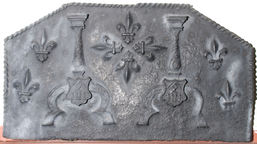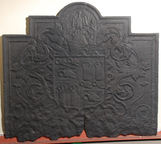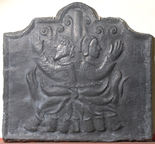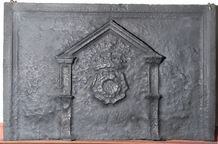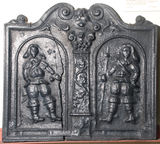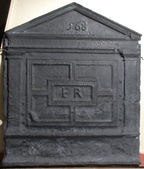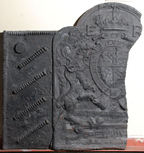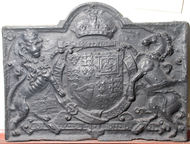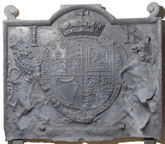-
392
Description: Arched rectangular shape; cavetto moulding on all sides, with short gaps at each end of the base (possibly to accommodate firedogs); date in top corners; shield, supporters, coronet and motto of the Barony of Bergavenny: Gules, on a saltire argent, a rose of the field, barbed and seeded proper. The motto, ‘Ne vile velis’ (Wish nothing base) is a pun on the family name.
Notes: The arms are those of William Nevill, 16th Baron Bergavenny, of Kidbrooke Park, Forest Row, Sussex. The date of the fireback coincides with the completion of the mansion. Formerly part of the J. H. Every collection.
Copies of this fireback are known.
Inscription: 1736 / NE VILE VELIS
Arms: William Nevill, 16th Baron Bergavenny
- Decoration tags:
- rectangular with round arch (shape)
- cavetto (edging)
- whole carved pattern
- individual numbers
- armorial
- text
Manufactured: in 1736 in the Weald area of England.
Current location: Anne of Cleves House, Southover High Street, Lewes, East Sussex, England.
Museum number: 1944.24.086 (part of the Sussex Archaeological Society museum group)
Citation: Hughes, G. B., 21 Apr 1955, 'Old English Firebacks', Country Life, 117, pp. 1056-60.
- Attached to series:
- Bergavenny firebacks
- Personal armorial firebacks
-
393
Description: Rectangular with canted top corners; twisted rope edging all round except base: plain plate with two stamps of an iron firedog with twisted neck and shield bearing letters HN and crossed staples; firedogs have columnar capitals; fleur de lys stamp repeated six times, singly at each end, in star pattern in middle; stamps have twisted wreaths.
Notes: The initials HN probably refer to Henry Nevill, the crossed staples being a badge of the Nevill family. Henry Nevill occupied Mayfield furnace from about 1585 until 1599. One of two variants (see no. 742) with the same firedogs and fleurs-de-lys; other firedogs in a very similar style are known. Formerly at Holmbush Farm, Hellingly, Sussex.
Inscription: HN HN
- Decoration tags:
- rectangular with canted top corners (shape)
- rope (edging)
- simple stamps
- carved stamps
- heraldic
- text
- objects
Manufactured: in the late-16th century possibly at Mayfield Furnace in the Weald area of England.
Current location: Anne of Cleves House, Southover High Street, Lewes, East Sussex, England.
Museum number: LH000.902 (part of the Sussex Archaeological Society museum group)
Citation: Anon., 30 Dec 1911, 'Sussex Backs and their Story', The Ironmonger.
Citation: Dawson, C., 1903, 'Sussex Iron Work and Pottery', Sussex Archaeological Collections, 46, pp. 1-54.
Citation: Gardner, J. S., 1898, 'Iron Casting in the Weald', Archaeologia, 56, 1, pp. 133-164.
- Attached to series:
- Henry Nevill series
- Firedog stamp firebacks
- Metalware stamp firebacks
-
394
Description: Rectangular, with arched rectangular extension on top; double astragal edging (top & sides); shield, helmet, crest and mantling of the Pelham family: quarterly, 1st and 4th, Azure, three pelicans vulning themselves proper; 2nd and 3rd, Gules, two broken belts palewise the buckles upwards argent; the crest: a peacock in pride argent.
Notes: The arms may be those of Sir Nicholas Pelham (1517-59) or of one of his two sons, Sir John (d. 1580) or Sir Thomas (c1540-1624); the latter was created a Baronet in 1611. As there is no evidence of the augmentation of a baronet on the arms, the fireback probably predates the creation of the baronetcy. Formerly part of the J. H. Every collection.
Copies of this fireback are known.
Arms: Sir Nicholas, Sir John or Sir Thomas Pelham
- Decoration tags:
- rectangular with round arch (shape)
- double astragal (edging)
- whole carved pattern
- armorial
Manufactured: in the early-17th century possibly at Waldron Furnace in the Weald area of England.
Current location: Anne of Cleves House, Southover High Street, Lewes, East Sussex, England.
Museum number: 1944.24.054 (part of the Sussex Archaeological Society museum group)
- Attached to series:
- Pelham family firebacks
- Personal armorial firebacks
- Low relief armorial series
-
396
Description: Cavetto-canted rectangle with arched top; astragal and cavetto edging (top and sides); pictorial; back-to-back figures of a bearded man and a woman in a poke bonnet, both dressed in tunics, their arms raised, respectively left and right; they are chained to a vertical pole; below, flames issue from vertically stacked logs, while smoke rises above them; the physical proportions of the figures are naïve, the man’s eyes being over-large, as are the hands of both.
Notes: The design is a free adaptation of an illustration from The Book of Martyrs by John Foxe (1563), a copy from a back originally noted at Brick Cottage, Burwash, Sussex, in 1871. This may be the design of fireback referred to in an enquiry printed in the St James's Chronicle, or British Evening Post, of 9 August 1788, which described it as 'having two Bishops burning at Stakes thereon' at a house in Warwickshire. At an auction sale in 2017 the same design of fireback was interpreted as the burning of Bishops Latimer and Ridley in 1555. Protestants were burnt to death at several Wealden locations as well as elsewhere in the south-east of England during the reign of Mary I, notably at Canterbury and Lewes. The subject of the fireback should be regarded as symbolic rather than commemorating any individual martyrs.
Copies of this fireback are known.
- Decoration tags:
- rectangular with canted top corners and round arch (shape)
- astragal with cavetto (edging)
- whole carved pattern
- pictorial
- historical
- humans
Manufactured: in the late-16th to early-17th century in the Weald area of England.
Current location: Anne of Cleves House, Southover High Street, Lewes, East Sussex, England.
Museum number: LH000.903 (part of the Sussex Archaeological Society museum group)
Citation: Butterfield, W. R., 1916, 'Old Wealden Firebacks', The Connoisseur, 46, pp. 197-209.
Citation: Dawson, C., 1903, 'Sussex Iron Work and Pottery', Sussex Archaeological Collections, 46, pp. 1-54.
Citation: Paine, C., Aug 2013, 'Mystery of the Two Martyrs', Sussex Past and Present, 130, pp. 6-7.
Citation: Straker, E., 1931, Wealden Iron (London, Bell).
- Attached to series:
- Commemorative firebacks
-
398
Description: Rectangular; cyma curve and fillet edging; crowned Tudor rose within a pediment resting on Tuscan pilasters and pedestals.
Notes: The rose and crown are more finely modelled than other versions.
Copies of this fireback are known.
- Decoration tags:
- rectangular (shape)
- cyma curve and fillet (edging)
- whole carved pattern
- heraldic
- architectural
- royal
Manufactured: in the mid- to late-16th century in the Weald area of England.
Current location: Anne of Cleves House, Southover High Street, Lewes, East Sussex, England.
Museum number: LH000.942 (part of the Sussex Archaeological Society museum group)
- Attached to series:
- Miscellaneous royal firebacks
- Pedimented rose and crown series
-
400
Description: Rectangular with two mirrored scrolls on top, a lion’s face between; ogee-moulded edging; central pilaster with vine scrolling, Corinthian capital, a diamond on the pedestal; on either side, an arched alcove with fillet edging, each with a halberdier in mid-17th century clothes, their feet pointing to the middle.
Notes: A more common version (no. 81) has different edging and the pattern-maker’s initials. Formerly part of the J. H. Every collection.
- Decoration tags:
- rectangular with ornate arch (shape)
- cyma reversa/ogee (edging)
- whole carved pattern
- pictorial
- architectural
- humans
Manufactured: in the mid-17th century possibly at Brede Furnace in the Weald area of England.
Current location: Anne of Cleves House, Southover High Street, Lewes, East Sussex, England.
Museum number: 1944.24.064 (part of the Sussex Archaeological Society museum group)
- Attached to series:
- Brede group
-
402
Description: Rectangular with pediment and frieze resting on fluted Tuscan pilasters; plain podium base; rectangular central panel with double fillet edge divided into four with central panel containing initials; date in tympanum.
Notes: An early example of the use of classical architectural elements in an English fireback. Formerly part of the J. H. Every collection.
Copies of this fireback are known.
Inscription: [1]568 / ER
- Decoration tags:
- rectangular with pediment (shape)
- none (edging)
- whole carved pattern
- architectural
- text
Manufactured: in 1568 in the Weald area of England.
Current location: Anne of Cleves House, Southover High Street, Lewes, East Sussex, England.
Museum number: 1944.24.062 (part of the Sussex Archaeological Society museum group)
- Attached to series:
- 1568 Architectural series
- Date & initials firebacks
-
403
Description: Fragment; arched rectangular shape with rounded corners; ovolo within fillet moulding all round; oval Tudor royal shield with garter surrounding, topped with a royal crown; dragon and (missing)greyhound supporters; initials split by crown; inscription on a fillet between legs of supporters, behind garter finial; motto on an Ionic plinth at bottom; rectangular side panels with twisted rope edging top and side; a short length of turned dowel stamped four times, diagonally, on each panel; a circular disc with concentric grooves in top left corner.
Notes: Similar to a fireback in the Victoria & Albert Museum, but differentiated by the twisted rope edging of the side panel and the addition of the grooved disc. The disparity between the worn surface of the armorial panel and the greater clarity of the extensions indicates that the extended casting was made using an already well-used armorial fireback and therefore at a substantially later date.
Inscription: E R / HONY SOIT QUE ... / Made in Sussex by J... / DV ET MOV...
Arms: Tudor royal - Edward VI
- Decoration tags:
- rectangular with round arch (shape)
- rope (edging)
- simple stamps
- carved stamps
- whole carved pattern
- extension panels
- armorial
- royal
- text
- objects
Manufactured: in the late-16th century in the Weald area of England.
Current location: Anne of Cleves House, Southover High Street, Lewes, East Sussex, England.
Museum number: LH000.916 (part of the Sussex Archaeological Society museum group)
- Attached to series:
- Pounsley series
- John Harvo series
- Tudor royal armorial firebacks
-
405
Description: Arched rectangular shape with small rhomboidal flanges in the corners of the arch; cavetto moulded edge on all sides; Stuart royal arms (1605-88, 1702-14) with lion and unicorn supporters, garter, crown and motto; raised inscription in a tapering label beneath crown.
Notes: An amended copy of a 17th/early 18th century original (see no. 633). The added inscription has been impressed with the personalised cast handle of a cooking vessel. A bronze skillet bearing the inscription 'STANDEN 1726' on its handle has been recorded elsewhere, but the impression on the fireback has been formed from a handle with the inscription inset in relief, whereas the 1726 inscription is inscribed. Also the lettering on the handle used to personalise the fireback, which includes the letter A surmounted with a horizontal line, is of an earlier style. Three members of the Standen family, Thomas, James and Elias, were founders at Beech or Robertsbridge furnaces, Sussex, 1728-9, and a John Standen was casting skillets at Heathfield Furnace in the early 1730s; each could have been the founder of the 1726 skillet, but the maker of the handle used in the fireback casting may have been earlier. Formerly at Marshalls Manor House, Maresfield, Sussex.
Inscription: IAMES STANDEN [+Garter and royal mottoes]
Arms: English Stuart royal
- Decoration tags:
- rectangular with round arch (shape)
- cavetto (edging)
- carved pattern panels
- whole carved pattern
- armorial
- royal
- text
Manufactured: in the late-17th to early-18th century in the Weald area of England.
Current location: Anne of Cleves House, Southover High Street, Lewes, East Sussex, England.
Museum number: LH000.943 (part of the Sussex Archaeological Society museum group)
Citation: Dawson, C., 1903, 'Sussex Iron Work and Pottery', Sussex Archaeological Collections, 46, pp. 1-54.
- Attached to series:
- Stuart royal armorial firebacks
- Miscellaneous stamp firebacks
-
406
Description: Arched rectangular shaped; convex moulding (top and sides surviving); scrolled protrusions above top corners; Stuart royal shield, crown, garter, supporters and motto; initials separated by crown.
Notes: The scrolled protrusions suggest a possible association with other firebacks with similar features. The Stuart arms in the same style are seen on another fireback (no. 1036).
Inscription: I R / HONI SOIT QVI MAL Y PENSE
Arms: English Stuart royal - James I
- Decoration tags:
- rectangular with round arch (shape)
- convex (edging)
- whole carved pattern
- armorial
- royal
- text
Manufactured: in the early-17th century possibly in the Weald area of England.
Current location: Anne of Cleves House, Southover High Street, Lewes, East Sussex, England.
Museum number: LH000.944 (part of the Sussex Archaeological Society museum group)

